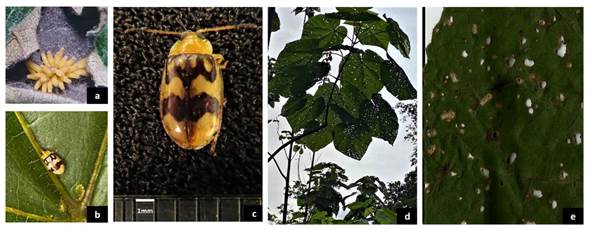Introduction
The species of the family Chrysomelidae are some of the most common beetles in the world. Most members of this family feed on the leaves of plants, both in their adult and larval stages. Specifically, adult individuals of the subfamily Galerucinae are considered skeletonizing leaf beetles since they only eat the tender parts of the leaf, leaving the skeleton of the veins (1).
Within the family Galerucinae is the genus Walterianella that has been reported causing total tree defoliation in Tabebuia rosea (Bertol.) DC. and Tectona grandis L. f. However, there are no additional reports on other species of trees (2).
Trees of the genus Paulownia belong to the family Paulowniaceae, order Lamiales. This genus comprises seventeen species, seven of which are native to China (3). Of these species, the most commonly used in forest projects are P. elongata S. Y. Hu, P. fortunei and P. kawakamii due to their fast growth, particularly during the first months of development (4), and their great adaptability to a wide range of soil and weather conditions (5).
The introduction of P. elongata into Costa Rica for commercial purposes started in 2016, with the main objective of producing sawmill wood and finished products. It is established as a monoculture and as a shade tree for coffee crops. However, there are limited technical and scientific information on its growth in different soil types, neither reports about pests and diseases.
Ten months after plantation establishment we discovered foliage damage in several trees and the damage agent was unknown until then. The objective of this paper was to report the presence of Walterianella inscripta Jacoby defoliating P. elongata trees.
Materials and methods
The plantation is located in the Province of Alajuela, San Carlos, Canton, District of Pital (10° 26 37.91 N y 84° 16 16.52 O''). The mean annual rainfall ranges from 3000 to 4000 mm, with a mean annual temperature of 25° C (6). The trees were established in October 2019, with a distance between 4 x 4 meters. In August 2020, assessed trees presented a mean diameter of 10.3 cm, and their heights ranged from 7 to 9 meters.
Adult individuals were randomly collected, and then sent for taxonomic identification to the Coleoptera expert. In addition, individuals in the instar of egg, and damaged leaves were collected for an adequate description. The average size of the damages was measured by means of digital pictures. 100 damage samples were measured using the image scientific processor software, ImageJ, version 1.52 (7).
Also, the incidence rate (I) (equation 1) and severity average rate (IPS) of the attack (equation 2) were determined, according to the methodology proposed by (8).
To assess severity, four categories were used with regard to affected foliage rate (Category A=0.1-25.0; B=26.0-50.0; C=51.0-75.0; D=76.0-100.0).
Results and discussion
Adult individuals were identified by taxonomic keys as Walterianella inscripta Jacoby (Coleoptera: Chrysomelidae). The eggs of this species are yellow, long and oblong (Fig 1A). The adult presents yellow antennae, where the last four segments are black; the body is oval-shaped; elytra are yellow with two brown cross bands; one of them at the base (with four oval yellowish spots) and another in the middle of the body (Figs 1B and 1C) (2,9).

Figure 1 Walterianella inscripta Jacoby (Coleoptera: Chrysomelidae). (a). Eggs. (b-c). Adult. (d). Damage to trees of Paulownia elongata S.Y. Hu, (e) Pattern of defoliation Pital, San Carlos, Costa Rica.
Figura 1. Walterianella inscripta Jacoby (Coleoptera: Chrysomelidae). (El). Huevos. (antes de Cristo). Alduto (D). Daños a árboles de Paulownia elongata S.Y. Hu, (e) Patrón de defoliación Pital, San Carlos, Costa Rica
The damage is caused by adult individuals of W. inscripta when feeding from parenchyma of the leaves of P.elongata, producing scratches and holes with an area ranging from 0.1 to 0.07 cm2 (Fig 1D). The damage incidence rate was 100%, and a Severity Average Rate of 79% (D category) is shown.
According to (2), the highest activity of these individuals occurs during daytime and rainy months of August and September. In Costa Rica, adults of Walterianella sp. have been reported to cause scratches in the upper cuticle and parenchyma of T. grandis leaves; the
extent of damage in a single leaf can cause its death and fall (10, 11, 12) which affects a decreased growth rate, and thus a reduced timber productivity
Conclusions
This is the first report on Walterianella inscripta causing damage to the species Paulownia elongata, in Costa Rica. Due to the severity of the damages, research on the population dynamics of W. inscripta, including its biology and behavior are required to support further studies for an accurate management of this species in Paulownia.
















